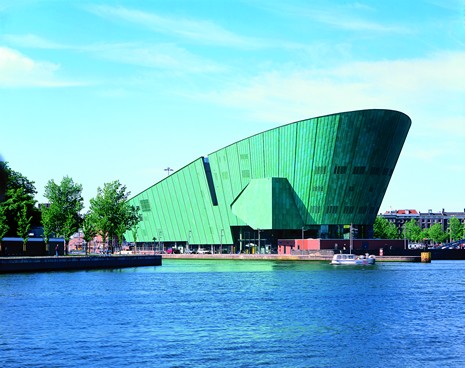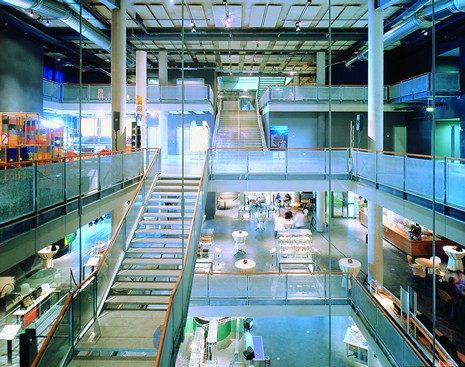Description
The intention of newMetropolis – which is more a communications centre than a museum – is to enable visitors take part in a variety of events in and around science and technology through interactive media. Exhibition halls for temporary exhibitions, a cinema, a science theatre, and a learning laboratory were to be housed in a single building, the design for which the architect (who did not have to enter a competition to win the commission) developed primarily out of the unusual urban situation at the historical port of Amsterdam.
According to the architect, the dynamic form of the museum (covered with copper cladding that had already acquired a patina) was not based on the naïve metaphor of a ship at anchor as the optimum visualisation of the Dutch technology of wresting land from the sea. Instead, the design idea resulted out of the location exactly above the entrance of a curved traffic tunnel. The rising contour of this museum is therefore supposed to mirror the street leading under the sea at the waterline but at the same time it also results in the building (requiring complex static structures because it rests for the most part on the tunnel itself and is additionally supported by pilings) reaching a maximum height of 32 metres. In a way, the museum is the “three-dimensional answer to the two-dimensional appearance of the city.” The dialectic relationship to the old part of the city – an unparalleled view of which is to be had from the freely accessible roof terrace – is also expressed in the contrast between the bricks typical of the area on the lower parts of the museum and the metal cladding signalling another world on those parts that tower above the city’s skyline.
Mostly artificially lit, in the museum’s interior, whose design was arrived at in close co-operation with the Anglo-Canadian exhibition team of James Bradburne, the architecture keeps itself as much in the background as possible, providing fluid space for the exhibits (mostly destined for experimentation). In so far it exemplifies an open museum space totally subordinate to function. The space is distributed across four levels, and it opens toward the middle, where unpretentiously designed stairways enable flexible circular tours.
architektur aktuell 209/1997, pp. 58-71 (Stefan Löffler) • The Architectural Review 1210/1997, pp. 54-58 (Peter Buchanan) • Contemporary Museums (Architectural Design Profile 130), 1997, II-V • The Renzo Piano Logbook, London, 1997, pp. 212-216 • Justin Henderson, Museum Architecture, London, 1998 , pp. 182-187 • Peter Buchanan, Renzo Piano Building Workshop. Complete Works, vol. 4, London, 2001, pp. 36-55
Drawings
Site plan
Second floor (entrance)
Fourth floor
Longitudinal section
East elevation
Design sketch: Waterline, street tunnel and museum contour
Photos

Exterior view from the northeast

Interior view from the third floor
Originally published in: Paul von Naredi-Rainer, Museum Buildings: A Design Manual, Birkhäuser, 2004.